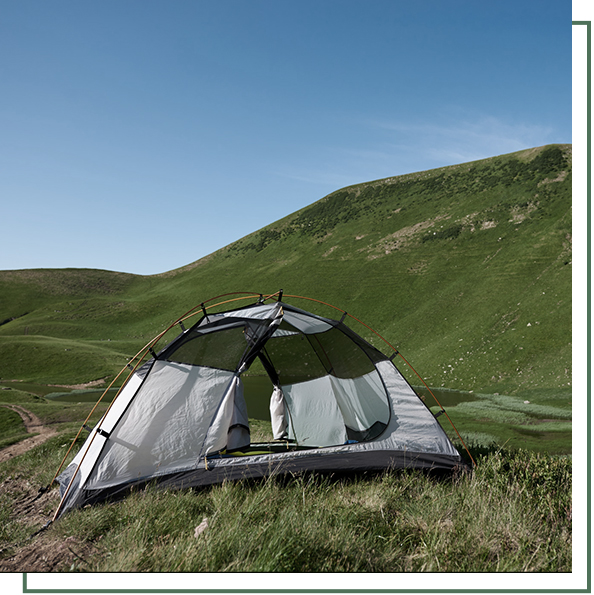News Center+ 查看更多
News Center
+ 查看更多
Expert Camping Tips+ 查看更多
Expert Camping Tips
+ 查看更多
Date:2023-06-19
Introduction:
When it comes to camping, a reliable and well-maintained tent
is essential for a comfortable and enjoyable experience.
In this article, we will provide expert tips on how to properly maintain your tent through waterproofing techniques.
By following these guidelines, you can minimize damage and extend the lifespan of your tent,
ensuring many memorable camping trips to come.

Understanding the Importance of Waterproofing:
The significance of waterproofing in preserving your tent's integrity and protecting against weather elements.
How proper waterproofing can prevent leaks, mold growth, and structural damage.
Assessing Your Tent's Current Condition:
Thoroughly inspecting your tent for signs of wear and tear,
including worn seams, holes, or damaged coatings.
Identifying areas that require immediate attention to prevent further deterioration.
Cleaning and Preparing Your Tent:
Step-by-step instructions on cleaning the tent,
including removing dirt, debris, and stains.
Recommendations for using mild cleaning agents and avoiding harsh chemicals that may damage the tent's fabric.

Applying Waterproofing Solutions:
Choose the Right Waterproofing Product:
Research and select a waterproofing product that is suitable for the material of your tent.
Different tents may require different types of waterproofing solutions.
Consider factors such as the tent fabric (e.g., nylon, polyester), coating,
and the level of waterproofing needed (e.g., light rain, heavy downpour).
Read the manufacturer's instructions and ensure that the product is compatible with your tent's material.
Prepare the Tent:
Set up your tent in a well-ventilated area, preferably outdoors,
to ensure proper air circulation during the waterproofing process.
Remove any dirt, debris, or stains from the tent's exterior using a mild detergent and water solution.
Allow the tent to dry completely before proceeding.
Apply the Waterproofing Solution:
Follow the manufacturer's instructions on how to apply the chosen waterproofing product.
Typically, waterproofing solutions come in the form of sprays, wash-in treatments, or brush-on coatings.
Start by focusing on the tent's seams, as they are the most vulnerable areas for water penetration.
Apply the waterproofing solution along the seams, ensuring thorough coverage.
Next, move on to the tent's fabric.
Spray or apply the solution evenly across the entire surface,
paying attention to areas prone to water accumulation,
such as the rainfly, the tent's floor, and the lower portions of the walls.
Use a soft brush or sponge to spread the solution and ensure it penetrates the fabric fibers.
Make sure to cover all areas, including the corners and edges.
Allow the waterproofing product to dry completely as per the manufacturer's instructions.
This may involve leaving the tent outdoors or in a well-ventilated area for a specified duration.
Test the Waterproofing:
Once the tent is dry, conduct a simple water test to check the effectiveness of the waterproofing treatment.
Spray water onto the tent's surface using a hose or a watering can.
Observe if the water beads up and rolls off the fabric or if it seeps through.
If water seeps through, reapply the waterproofing solution to the affected areas or consider using a stronger waterproofing product.
Additional Considerations:
Take care not to over saturate the tent with the waterproofing solution,
as this may affect its breath ability and could lead to condensation issues.
Avoid spraying the solution directly on tent zippers, as it may cause them to become stiff or difficult to operate.
Instead, apply a lubricant specifically designed for zippers after waterproofing the tent.
Remember, regular maintenance and reapplication of waterproofing solutions
may be necessary, especially if you frequently use your tent or expose it to harsh weather conditions.
By properly applying waterproofing solutions, you can enhance your tent's ability to repel water,
keeping you dry and comfortable during your camping adventures.

Maintaining Tent Zippers:
Keep Zippers Clean:
- Regularly inspect the zippers of your tent and ensure they are free from dirt, debris, and sand particles. These can accumulate over time and cause zipper malfunctions.
- Gently brush off any loose dirt or debris from the zipper tracks using a soft-bristled brush or a toothbrush.
- If there is stubborn dirt or residue, use a mild detergent or soap solution and a soft cloth to clean the zipper. Avoid using harsh chemicals or abrasive materials that may damage the zipper.
- Lubricate the Zippers:
- Lubrication is crucial for smooth zipper operation and to prevent them from getting stuck or jammed.
- Apply a zipper lubricant specifically designed for outdoor gear or tent zippers. These lubricants usually come in the form of waxes, silicone-based gels, or sprays.
- Follow the product instructions and apply a small amount of lubricant along the zipper teeth and tracks.
- Gently slide the zipper back and forth to distribute the lubricant evenly and ensure smooth operation.
- Avoid Excessive Force:
- Encourage proper zipper usage by educating users to avoid pulling or yanking on the zippers with excessive force. This can strain the zipper teeth and lead to damage or separation.
- Instruct users to hold the fabric on both sides of the zipper and apply gentle, even pressure while zipping or unzipping the tent.
- Repair or Replace Damaged Zippers:
- Periodically inspect the zippers for any signs of damage, such as missing or bent teeth, broken sliders, or frayed zipper fabric.
- If you notice any issues, consider repairing or replacing the damaged components promptly to ensure the zipper functions properly.
- Many outdoor gear repair shops offer zipper repair services, or you can consult the tent manufacturer for replacement parts or recommendations.
- Store the Tent Properly:
- When not in use, store the tent in a clean and dry environment to minimize the risk of zipper damage.
- Avoid folding or packing the tent with the zippers under tension, as this can strain and weaken them over time.
- Store the tent loosely in a breathable storage bag or hang it in a cool, dry place to maintain the integrity of the zippers.
By implementing these practices for maintaining tent zippers, you can prolong their lifespan and ensure smooth functionality. Well-maintained zippers contribute to the overall durability and usability of your tent, providing a hassle-free camping experience.

Storing Your Tent
Properly storing your tent is essential for preserving its quality and prolonging its lifespan.
Here are some guidelines to follow when storing your tent:
- Clean and Dry the Tent:
- Before storing your tent, make sure it is thoroughly clean and dry. Any moisture, dirt, or debris left on the tent can promote mold or mildew growth and cause damage over time.
- Set up the tent outdoors or in a well-ventilated area and gently shake off any loose dirt or debris. Use a soft brush or cloth to remove stubborn stains or residue.
- If needed, spot clean the tent using a mild soap or tent cleaner and rinse it thoroughly with water. Ensure that the tent is completely dry before proceeding with storage.
- Disassemble the Tent Properly:
- Take down the tent following the manufacturer's instructions. Be careful not to force or rush the disassembly process, as this can lead to tears or broken components.
- Start by removing any tent stakes, guy lines, and accessories. Then, collapse the tent poles and fold the tent fabric neatly.
- Avoid sharp folds or creases that can weaken the tent fabric. Instead, try loosely rolling or stuffing the tent into its storage bag to minimize stress on the material.
- Use a Breathable Storage Bag:
- Choose a storage bag that is breathable and allows air circulation. Avoid using plastic bags or airtight containers, as they can trap moisture and promote mold growth.
- Ideally, use the original tent stuff sack or invest in a larger storage bag that provides enough space for the tent and its accessories.
- If the tent is slightly damp, ensure it is completely dry before placing it in the storage bag to prevent musty odors or mildew.
- Store in a Cool, Dry Place:
- Find a cool, dry, and well-ventilated area for storing your tent. Extreme temperatures, high humidity, and direct sunlight can damage the tent fabric and coatings.
- Avoid storing the tent in a basement, attic, or any place prone to moisture or temperature fluctuations.
- If possible, elevate the storage bag off the ground to prevent moisture absorption from the floor.
- Regularly Check and Air Out:
- Periodically check on your stored tent to ensure it remains in good condition. Inspect for any signs of mold, mildew, or pest infestation.
- If you notice any issues, take immediate action to address them. Clean the affected areas or seek professional tent cleaning services if necessary.
- It's also a good practice to air out your tent occasionally, especially during dry and sunny days. Set it up outdoors in a shaded area to allow fresh air to circulate and prevent musty odors.
you can maintain its integrity and be ready for your next camping adventure.
Proper storage ensures that your tent is in optimal condition,
prolonging its lifespan and providing you with years of reliable use.
Seasonal Maintenance
Performing regular seasonal maintenance on your tent is crucial for keeping it in top condition and maximizing its lifespan.
Here are some important steps to include in your seasonal maintenance routine:
- Inspection and Cleaning:
- Start by thoroughly inspecting your tent for any signs of damage, such as rips, tears, or worn-out areas. Check the seams, zippers, poles, and guy lines for any issues that may need attention.
- If you notice any damage, make the necessary repairs before proceeding with the cleaning process.
- Clean the tent by setting it up outdoors or in a well-ventilated area. Gently shake off loose dirt or debris, and use a soft brush or cloth to remove stains or residue.
- Prepare a mild soap solution or use a specialized tent cleaner. Spot clean the affected areas and rinse thoroughly with water. Avoid using harsh chemicals or abrasive scrubbing, as they can damage the tent fabric or coatings.
- Allow the tent to dry completely before proceeding to the next step.
- Waterproofing:
- Apply a waterproofing treatment to maintain or enhance the tent's water repellency. This is especially important if you notice water seeping through the fabric during your camping trips.
- Choose a high-quality tent waterproofing product that is suitable for the tent material. Follow the manufacturer's instructions for application, ensuring even coverage on the exterior of the tent.
- Pay extra attention to areas prone to water penetration, such as the seams, flysheet, and tent floor. Use a brush or sponge to evenly distribute the waterproofing solution, and allow it to dry thoroughly.
- Tent Pole Inspection:
- Inspect the tent poles for any signs of damage, such as bends, cracks, or corrosion. Damaged poles can compromise the tent's stability and functionality.
- If you identify any issues with the poles, consider replacing them with compatible replacements from the tent manufacturer or authorized retailers.
- Ensure that the pole segments fit together properly and that the shock cord is in good condition. Replace any worn-out shock cord as needed.
- Guy Lines and Tent Stakes:
- Check the condition of the guy lines and tent stakes. Replace any damaged or worn-out components to ensure proper tensioning and stability during windy conditions.
- Clean the tent stakes to remove dirt or rust, and store them in a dry place to prevent corrosion.
- Storage:
- Once you have completed the seasonal maintenance tasks, follow the proper storage guidelines outlined earlier to store your tent in a cool, dry place.
- Make sure the tent is completely dry before packing it away to prevent mildew or musty odors.
- Consider using a storage bag or container that allows air circulation and protects the tent from dust or pests.
you can ensure that your tent remains in excellent condition and performs optimally throughout its lifespan.
Regular inspections, cleaning, waterproofing, and addressing any repairs promptly will help you
enjoy many memorable camping experiences with your well-maintained tent.
Conclusion:
By implementing these expert camping tips for waterproof maintenance,
you can ensure your tent remains in excellent condition for years to come.
Regular cleaning, proper storage, and proactive waterproofing measures will extend the lifespan of your tent,
allowing you to enjoy countless outdoor adventures without worry.
Remember, a well-maintained tent is your gateway to unforgettable camping experiences.


